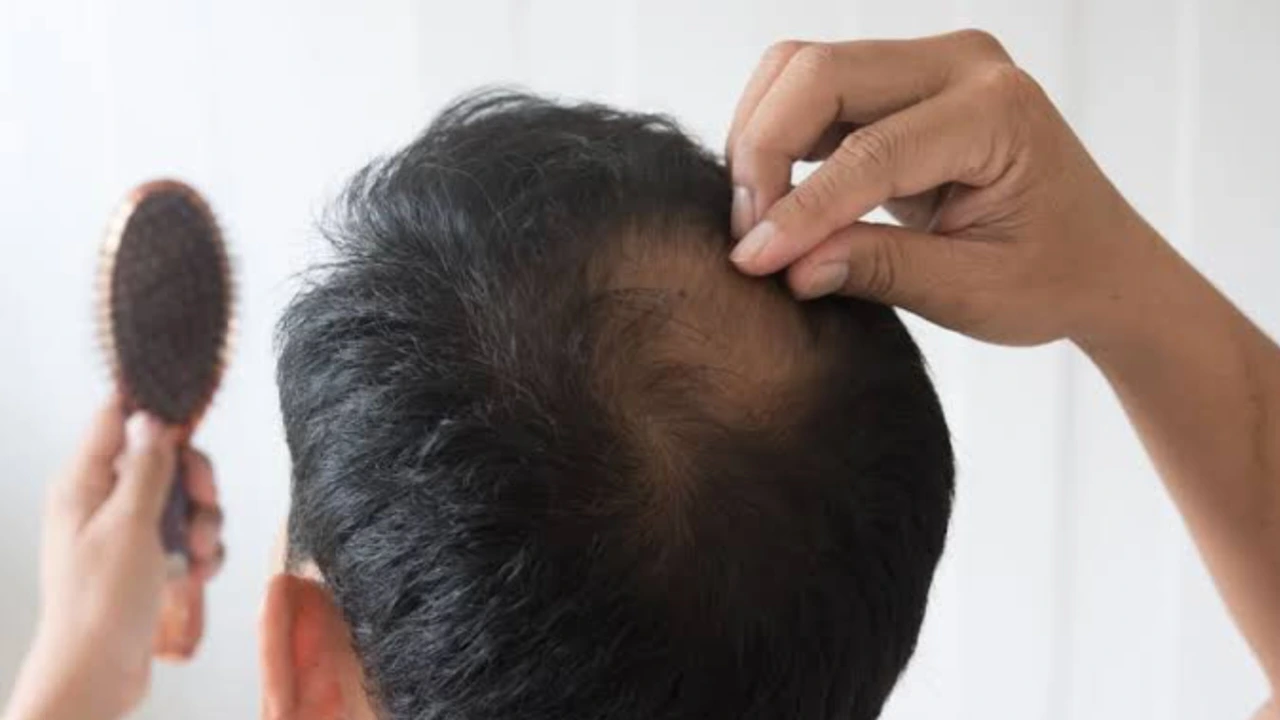Alopecia areata is baldness or hair loss caused by an autoimmune disease. In alopecia areata, the immune system attacks and damages the hair roots, causing hair loss and baldness. A bald scalp with a bald patch is one sign of this condition.
Alopecia areata occurs when the hair follicles shrink and stop producing hair. This then causes hair loss and baldness . This condition can occur gradually or suddenly.
In addition to causing bald patches on the scalp, alopecia areata can also cause baldness in one area completely. This type of alopecia areata is called
alopecia areata totalis. In addition, there is also alopecia areata that occurs in all hairy areas of the body, or is called alopecia areata universalis.
Alopecia areata can happen to anyone, both men and women. However, alopecia areata usually occurs before the sufferer is 30 years old. This condition also most often affects the hair on the scalp.
Causes of Alopecia Areata
Alopecia areata is caused by the immune system attacking hair follicles (autoimmune disease). This condition causes hair production to stop so that hair falls out and eventually becomes bald.
It is not yet known for certain why the immune system attacks and damages hair follicles. However, this condition is thought to be triggered by viral infections , trauma, hormonal changes, and physical or psychological stress.
Risk factors for alopecia areata
Although the exact cause is not yet known, there are several factors and conditions that can increase a person’s risk of developing alopecia areata, namely:
- Having a parent or close family member with alopecia areata or another autoimmune disease
- Suffering from a chromosomal disorder, such as Down syndrome
- Suffering from vitamin D deficiency , asthma, atopic dermatitis , lupus, vitiligo , or thyroid disease, such as Hashimoto’s disease and Graves’ disease
Symptoms of Alopecia Areata
Alopecia areata can affect all ages, but is more common in children, adolescents, or young adults. This condition can cause baldness or hair loss in several parts of the body, such as the scalp, eyebrows, eyelashes, nose hair, armpits, genitals, mustache, or beard.
The main symptom of alopecia areata is painless hair loss or baldness. Like other autoimmune diseases, baldness and hair loss experienced by alopecia areata sufferers can be recurrent.
In addition, there are several other signs that can occur when someone experiences alopecia areata, namely:
- Baldness that appears in one or more places where hair used to grow is called a round or patchy bald spot.
- Baldness occurs at the bottom, sides, or around the back of the head (ophiasis alopecia)
Generally, hair loss in alopecia areata sufferers can grow back on its own. However, in some sufferers, baldness can be permanent so that hair does not grow back.
The nails of people with alopecia areata also often experience changes, such as nails appearing reddish, grooved, or becoming rough and thin so that they split easily.
When to see a doctor
See a doctor if you experience baldness or unusual hair loss. Early detection can help you find out the cause of your hair loss. That way, your doctor can take appropriate treatment measures based on the cause and condition you are experiencing.
Diagnosis of Alopecia Areata
To diagnose alopecia areata, the doctor will ask about the patient’s symptoms and medical history. After that, the doctor will perform a physical examination, including examining the areas of the body that normally have hair, as well as the patient’s nails.
To establish a diagnosis and determine the cause of hair loss, supporting examinations are needed, such as:
Scalp biopsy
A biopsy is performed by taking a sample from the scalp to be examined under a microscope. A biopsy is performed to detect abnormalities in cells and tissues in the scalp and to determine the cause of hair loss or baldness.
Blood test
This test is performed if the patient is suspected of having an autoimmune disease or other disease that can cause baldness and hair loss. Some things that will be assessed and detected during the blood test are:
- Antinuclear antibodies (ANA)
- C-reactive protein
- Erythrocyte sedimentation
- Iron
- Thyroid hormone
- Testosterone
- Follicle stimulating hormone (FSH)
- Luteinizing hormone (LH)
Alopecia Areata Treatment
There is no cure for alopecia areata. However, there are treatments that can relieve symptoms, prevent recurrence, and help people adapt and accept their condition.
Treatment for alopecia areata by a doctor involves administering medication and counseling. In addition, there are several self-management treatments that can be done to reduce discomfort caused by this disease. Here is the explanation:
Drugs
In some cases, hair loss and baldness experienced by alopecia areata sufferers can recover on their own. The doctor may prescribe medication to stimulate hair growth. The medications that may be prescribed are:
Minoxidil
This medication is used to stimulate hair growth. The usual dosage form of minoxidil used to treat baldness due to alopecia areata is topical or applied. New hair growth can be seen 3 months after using this medication.
Corticosteroids
Corticosteroid drugs are used to suppress the immune system. These drugs are available in the form of injections, topical, and tablets. Injections are usually given to adult patients, while topical drugs are generally given to children. While corticosteroid tablets are consumed by people with extensive baldness.
Baricitinib
If alopecia areata is severe or causes total baldness, doctors can prescribe stronger immunosuppressant drugs. An example is baricitinib.
Anthralin
This medicine is used to treat bald scalp. After being applied and left on as recommended by the doctor, anthralin should be washed off thoroughly so that the skin does not become irritated.
Diphencyprone (DPCP)
Diphencyprone is a drug used to distract the immune system from attacking hair follicles. It is applied to bald areas of the skin. One sign that the drug is working is the appearance of contact dermatitis .
Counseling and support groups
To overcome emotional disorders and increase self-confidence, patients can undergo counseling with a psychologist. In addition, patients can join a group (support group) for alopecia areata sufferers, to share experiences and reduce stress.
Self-management
Although not dangerous, alopecia areata can cause discomfort due to the baldness experienced. Here are some ways that can be done to overcome this discomfort:
- Using wigs, hats, and applying sunscreen cream to bald areas, to protect the skin from the sun.
- Shaving the head, moustache, or beard to improve appearance
- Wear glasses or false eyelashes to protect your eyes from dust if you suffer from baldness in your eyebrows and eyelashes.
Complications of Alopecia Areata
Alopecia areata does not cause complications that are dangerous to sufferers. In addition, this condition is also not contagious. However, there are several complications that can occur in people with alopecia areata, namely:
- Permanent baldness in 10% of sufferers
- Emotional disturbances that can lead to anxiety disorders and depression
- Social relationship disorders, due to low self-confidence
In addition, alopecia areata is often associated with an increased risk of developing other immune system disorders, such as asthma, vitiligo , lupus, or atopic dermatitis.
Prevention of Alopecia Areata
Alopecia areata is difficult to prevent, considering the exact cause is unknown. However, for people with autoimmune diseases, it is recommended to have regular check-ups with a doctor to monitor the condition.
In addition, stress relief is believed to help prevent alopecia areata. Ways to relieve stress include meditation, relaxation techniques, getting enough sleep, and breathing exercises.
References :
Burns, L., et al. (2020). Cumulative Life Course Impairment of Alopecia Areata. International Journal of Trichology, 12(5), pp. 197–204.
Żeberkiewicz, M., Rudnicka, L., & Malejczyk, J. (2020). Immunology of Alopecia Areata. Central-European Journal of Immunology, 45(3), pp. 325–33.
American Academy of Dermatology Association (2022). Diseases & Conditions. Hair Loss Types: Alopecia Areata Overview.
National Institutes of Health (2020). MedlinePlus. Alopecia Areata.
Cleveland Clinic (2018). Diseases & Conditions. Alopecia Areata.
Mayo Clinic (2022). Diseases & Conditions. Hair Loss.
Bhargava, H. WebMD (2020). Alopecia Areata.
Bolduc, C. Medscape (2020). Alopecia Areata.
Brannon, H. Verywell Health (2021). What Is Alopecia Areata?
Cafasso, J. Healthline (2022). Everything You Need to Know About Alopecia Areata.
Cole, G. MedicineNet (2022). Alopecia Areata.
Family Doctor (2021). Alopecia Areata (AA).
Hussain, K. DermNet (2019). Psychological Effects of Hair Loss.
Lepe, K., & Zito, P. Statpearls (2021). Alopecia Areata.
Ragland, L. WebMD (2021). Ways to Manage Stress.
Zimlich, R. Verywell Health (2021). Blood Tests for Autoimmune Diseases.

